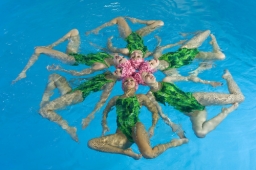Resolving Conflict within a Youth Sport Team
Wednesday, April 5, 2017 - 09:25

Being part of a team can be one of the most supportive environments to learn and grow as an athlete and as an individual. Teammates aspire to work together in harmony to achieve success, sometimes reaching a higher level than an individual could on their own. However, pushing both ourselves as athletes and our teams to improve can be a challenging process. Sport by nature can be competitive and fraught with conflict. Working with multiple personalities and strengths can cause friction, frustration and conflict between teammates. When teammates are in conflict it can have a huge impact on team dynamics and team cohesion. It is how we work through the elements of conflict that helps us determine success.
What can the coach do to prevent conflict?
No matter how well your team appears to get along, there are always times when conflict comes up. Young athletes are still building the necessary skills needed to work through complex and emotional issues and the coach plays an important role in teaching strategies for teams to work better together.
- Educate the team - Set the stage at the beginning of the season in terms of expectations around open communication, positive teammate interaction and conflict resolution. Make the team aware of the impact of conflicts on a team and its success. Acknowledging possible areas of conflict will help athletes recognize tensions as they evolve and help athletes feel safe and secure in managing these challenging situations. Establishing team values around trust and respect will provide a solid foundation for team success and conflict prevention.
- Encourage communication – Many conflicts stem from miscommunication or misinterpretation. When the team environment supports open and honest communication, athletes feel comfortable bringing issues forward to be dealt with instead of letting concerns fester, frustrations build, and tension become disruptive to team unity.
- Provide a common goal – Engage the team in setting a few simple team goals at the beginning of the season. Having these goals in place and referring back to them in both good and bad times will remind your athletes and help them move beyond areas of conflict by refocusing away from the personal to the group goal. It is ok not to agree on everything as a team, but it is important to remember that they are all on the same side for the team’s overall success. These team goals should be everyone’s priority.
- Promote a positive atmosphere – Conflicts cause a very negative atmosphere, so it is important to refocus the individual athletes or the team on positive behaviours concentrated on solving the problem at hand to move forwards in achieving the team’s goal.
- Be a role model – Young athletes are aware of the environment around them. Coaches and parents can be role models for conflict avoidance and resolution behaviour. Set an example of honesty, calm demeanor, and positive conflict resolution. Show them that they can debate and disagree with others in a respectful way. Seeing a successful example of how it can be done will set the stage as future challenges arise.
What can athletes do to resolve conflict?
We all understand that there are people in our lives that may never be our best friends, but we can still work together with them to reach a common goal. As an athlete there are number of things we can try when we’re struggling to get along:
- Be professional – Keep a calm and collected demeanor. Be the bigger person and rise above any argumentative behaviour. Focus on the team and working together. Try to keep personal emotions at bay, perhaps by taking a few minutes to step away from the situation to breathe and focus on positive communication.
- Be honest – If possible, work toward a resolution with the individual involved. Explain what you think the issue is in a non-personal way, how you feel the issue might be negatively impacting the team and what you think you both could do to resolve the situation. Athletes should be able to rise above personal issues for the benefit of team success. Do not make the discussion personal and avoid placing blame.
- Don’t take sides – The only side that should be taken is the side of the team itself. Taking sides only encourages divisive behaviour and increases tensions and animosity.
- Talk to the coach – If issues cannot be resolved on a person to person basis, talk to the coach for advice on your role and behaviour or enlist their help in working towards a team solution.
- Address the conflict off the field – Personal issues between teammates should not be aired on the field of play and frustrations should not be taken out in the group setting impacting team performance. Support the player and the team during competition and training.
Teams work together successfully when they are built on a foundation of respect and trust. If either of these two elements are damaged a team will struggle to perform at their best. Each member of the team holds an equal share of responsibility in maintaining and strengthening the team bond. By working together with coaches to create and support open communication and common goals, interpersonal conflict can be avoided and teams can thrive. If conflicts do arise, working through them by focusing on the common goal can actually strengthen the team in the long run.
Sources:
Bourgase B. Conflict within Teams. Coach Brock Bourgase.
Dan. (2017). Playing Peacekeeper: Tips for Resolving Conflict Between Players. Steellocker Sports.
Hedstrom R. Coaching Through Conflict: Effective Communication Strategies. Association for Applied Sport Psychology.
Meredith J. (2016). Teach Your Young Athletes how to Fight. USA Football.
Snider J. (2016). What to do when you don’t get along with a teammate. Future Stars Summer Camps.